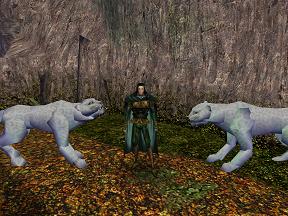Crag Cat: Difference between revisions
(cts crag cat) |
mNo edit summary |
||
| Line 1: | Line 1: | ||
{{Animal_Companion_Research | {{Animal_Companion_Research | ||
|Name_of_Creature= Crag Cat | |Name_of_Creature= Crag Cat | ||
|Companion_Submission_Status= | |Companion_Submission_Status= accepted | ||
|CTS_Code= 94 | |CTS_Code= 94 | ||
|Type_of_Creature= Feline | |Type_of_Creature= Feline | ||
Revision as of 03:28, 23 September 2009
| Animal Companion Training | Fauna Lore | Submit Research on a New Companion |

Research
Creature Name: Crag Cat
Observations by: Jensen Rintel
Creature Type: Feline ((94))
Creature Subtype: None listed.
CTS trainable: Yes (compatible with CTS).
Introduction
Crag Cats are slender and agile cats. Adults stand about 3.0 to 3.5 ft tall at the shoulders. The length of the an adult is around 8 ft long nose to tail. Both Males and Females have an average weight of about 135 to 190 pounds. In rare cases, some may reach over 300 lb. The head of the cat is round and the ears erect. Its powerful forequarters, neck, and jaw serve to grasp and hold large prey. It has five retractable claws on its forepaws and four on its hind paws. The larger front feet and claws are adaptations to clutching prey. The musculature of this animal can be seen in its graceful movements, and can sometimes be underestimated.
The head of the cat is round and the ears erect. Its powerful forequarters, neck, and jaw serve to grasp and hold large prey. It has five retractable claws on its forepaws and four on its hind paws. The larger front feet and claws are adaptations to clutching prey. The musculature of this animal can be seen in its graceful movements, and can sometimes be underestimated.
Crag Cats cannot roar, lacking the specialized larynx to do so. Like domestic cats, Crag Cats vocalize low-pitched hisses, growls, and purrs, as well as chirps and whistles. They are well known for their screams, although these may often be the misinterpreted calls of other animals like the Kirre, Panther, and Cougar.
Crag Cat coloring is plain, but can vary greatly between individuals and even between siblings. The coat is typically silvery-grey to white, with lighter patches on the under body including the jaws, chin, and throat. Black circle spots and markings are apparent across its body. Infants are born with blue eyes and rings on their tails; juveniles are pale, and dark spots remain on their flanks.
Crag Cats have large paws and proportionally the largest hind legs in the cat family. This physique allows it great leaping and short-sprint ability. It is adept at climbing, which allows it to evade canine competitors. Although it is not strongly associated with water, it can swim.
Feeding Habits
A successful generalist predator, the Crag Cat will eat any animal it can catch, from insects to large animals. Like all cats, it is an obligate carnivore, feeding only on meat. Its most important prey species are various deer species. Other species such as Bighorn Sheep, infant owlbears, horses, and domestic livestock such as cattle and sheep are also primary food chooses. Birds and small reptiles are sometimes preyed upon, but this is rarely seen.
Though capable of sprinting, the cougar is typically an ambush predator. It stalks through brush and trees, across ledges, or other covered spots, before delivering a powerful leap onto the back of its prey and a suffocating neck bite. The cougar is capable of breaking the neck of some its smaller prey with a strong bite and momentum bearing the animal to the ground.
Disposition and Social Habits
None listed.
Habitat
Forest areas.
Fylgia
Most compatible: Panther
Other notes
The Knowledge to tame such a creature is not yet available in this world. Yet you sense a connection between you and this creature and you fell the number 94 is some how a key. The fabled “Hunter-of-Man” is a sure-footed predator of the North. More than just a simple Bobcat, however, it wields some magical properties as well.